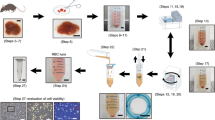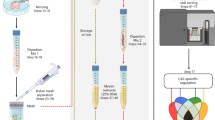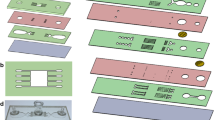Abstract
Here, we present a protocol for the isolation of endothelial cells (ECs) from tissues. ECs make up a minor population of cells in a tissue, but play a major role in tissue homeostasis, as well as in diverse pathologies. To understand the biology of ECs, characterization of this cell population is highly desirable, but requires the availability of purified cells. For this purpose, tissues are mechanically minced and subsequently digested enzymatically with collagenase and dispase. ECs in the resulting single-cell suspension are labeled with Abs against EC surface antigens and separated from the remainder of the cells and debris by capture with magnetic beads or by high-speed cell sorting. Purified ECs are viable and suitable for characterization of diverse cellular properties. This protocol is optimized for human tissues but can also be adapted for use with other species. Depending on the tissue, the procedure can be completed in ∼6 h.
This is a preview of subscription content, access via your institution
Access options
Subscribe to this journal
Receive 12 print issues and online access
$259.00 per year
only $21.58 per issue
Buy this article
- Purchase on Springer Link
- Instant access to full article PDF
Prices may be subject to local taxes which are calculated during checkout





Similar content being viewed by others
References
Folkman, J. Angiogenesis in cancer, vascular, rheumatoid and other disease. Nat. Med. 1, 27–31 (1995).
Griffioen, A.W. & Molema, G. Angiogenesis: potentials for pharmacologic intervention in the treatment of cancer, cardiovascular diseases, and chronic inflammation. Pharmacol. Rev. 52, 237–268 (2000).
van Beijnum, J.R. et al. Gene expression of tumor angiogenesis dissected: specific targeting of colon cancer angiogenic vasculature. Blood 108, 2339–2348 (2006).
Hida, K. et al. Tumor-associated endothelial cells with cytogenetic abnormalities. Cancer Res. 64, 8249–8255 (2004).
Ades, E.W. et al. HMEC-1: establishment of an immortalized human microvascular endothelial cell line. J. Invest. Dermatol. 99, 683–690 (1992).
Grange, C. et al. Isolation and characterization of human breast tumor-derived endothelial cells. Oncol. Rep. 15, 381–386 (2006).
Folkman, J., Haudenschild, C.C. & Zetter, B.R. Long-term culture of capillary endothelial cells. Proc. Natl. Acad. Sci. USA 76, 5217–5221 (1979).
Manconi, F., Markham, R. & Fraser, I.S. Culturing endothelial cells of microvascular origin. Methods Cell Sci. 22, 89–99 (2000).
Hillen, H.F., Melotte, V., van Beijnum, J.R. & Griffioen, A.W. Endothelial cell biology. In Angiogenesis Assays: A Critical Appraisal of Current Techniques (eds. Staton, C., Lewis, C. & Bicknell, R.) 1–38 (John Wiley & Sons, Chichester, West Sussex, UK, 2006).
van Beijnum, J.R., van der Linden, E. & Griffioen, A.W. Angiogenic profiling and comparison of immortalized endothelial cells for functional genomics. Exp. Cell Res. 314, 264–272 (2008).
Ibrahim, S.F. & van den Engh, G. High-speed cell sorting: fundamentals and recent advances. Curr. Opin. Biotechnol. 14, 5–12 (2003).
Wynick, D. & Bloom, S.R. Magnetic bead separation of anterior pituitary cells. Neuroendocrinology 52, 560–565 (1990).
Fritsch, G. et al. Characterization of hematopoietic stem cells. Ann. NY Acad. Sci. 770, 42–52 (1995).
Simpson, J.L. & Elias, S. Isolating fetal cells from maternal blood. Advances in prenatal diagnosis through molecular technology. JAMA 270, 2357–2361 (1993).
Garner, D.L. Flow cytometric sexing of mammalian sperm. Theriogenology 65, 943–957 (2006).
Favre, C.J. et al. Expression of genes involved in vascular development and angiogenesis in endothelial cells of adult lung. Am. J. Physiol. Heart Circ. Physiol. 285, H1917–H1938 (2003).
Hewett, P.W. & Murray, J.C. Immunomagnetic purification of human microvessel endothelial cells using Dynabeads coated with monoclonal antibodies to PECAM-1. Eur. J. Cell Biol. 62, 451–454 (1993).
Abbot, S.E., Kaul, A., Stevens, C.R. & Blake, D.R. Isolation and culture of synovial microvascular endothelial cells. Characterization and assessment of adhesion molecule expression. Arthritis Rheum. 35, 401–416 (1992).
Grimwood, J., Bicknell, R. & Rees, M.C. The isolation, characterization and culture of human decidual endothelium. Hum. Reprod. 10, 2142–2148 (1995).
Madden, S.L. et al. Vascular gene expression in nonneoplastic and malignant brain. Am. J. Pathol. 165, 601–608 (2004).
Parker, B.S. et al. Alterations in vascular gene expression in invasive breast carcinoma. Cancer Res. 64, 7857–7866 (2004).
St. Croix, B. et al. Genes expressed in human tumor endothelium. Science 289, 1197–1202 (2000).
Buckanovich, R.J. et al. Tumor vascular proteins as biomarkers in ovarian cancer. J. Clin. Oncol. 25, 852–861 (2007).
Seaman, S. et al. Genes that distinguish physiological and pathological angiogenesis. Cancer Cell 11, 539–554 (2007).
Lu, C. et al. Gene alterations identified by expression profiling in tumor-associated endothelial cells from invasive ovarian carcinoma. Cancer Res. 67, 1757–1768 (2007).
van Beijnum, J.R. & Griffioen, A.W. In silico analysis of angiogenesis associated gene expression identifies angiogenic stage related profiles. Biochim. Biophys. Acta 1755, 121–134 (2005).
Dirkx, A.E. et al. Tumor angiogenesis modulates leukocyte-vessel wall interactions in vivo by reducing endothelial adhesion molecule expression. Cancer Res. 63, 2322–2329 (2003).
Griffioen, A.W. Phenotype of the tumor vasculature; cell adhesion as a target for tumor therapy. Cancer J. 10, 249–255 (1997).
Baeten, C.I., Wagstaff, J., Verhoeven, I.C., Hillen, H.F. & Griffioen, A.W. Flow cytometric quantification of tumour endothelial cells; an objective alternative for microvessel density assessment. Br. J. Cancer 87, 344–347 (2002).
Wang, Y. & Sheibani, N. Expression pattern of alternatively spliced PECAM-1 isoforms in hematopoietic cells and platelets. J. Cell. Biochem. 87, 424–438 (2002).
Castermans, K. & Griffioen, A.W. Tumor blood vessels, a difficult hurdle for infiltrating leukocytes. Biochim. Biophys. Acta 1776, 160–174 (2007).
Acknowledgements
This work was supported by grants of the transnational University Limburg (tUL), GROW—School for Oncology and Developmental Biology and the sixth EU Framework Programme (Integrated Project 'Angiotargeting'; contract no. 504743). We thank Petra Hautvast for technical assistance.
Author information
Authors and Affiliations
Corresponding author
Rights and permissions
About this article
Cite this article
van Beijnum, J., Rousch, M., Castermans, K. et al. Isolation of endothelial cells from fresh tissues. Nat Protoc 3, 1085–1091 (2008). https://doi.org/10.1038/nprot.2008.71
Published:
Issue Date:
DOI: https://doi.org/10.1038/nprot.2008.71
This article is cited by
-
Extracellular vimentin mimics VEGF and is a target for anti-angiogenic immunotherapy
Nature Communications (2022)
-
Human lung-cancer-cell radioresistance investigated through 2D network topology
Scientific Reports (2022)
-
A novel strategy for isolation of mice bone marrow endothelial cells (BMECs)
Stem Cell Research & Therapy (2021)
-
Mitigating the non-specific uptake of immunomagnetic microparticles enables the extraction of endothelium from human fat
Communications Biology (2021)
-
FUNDC1-dependent mitochondria-associated endoplasmic reticulum membranes are involved in angiogenesis and neoangiogenesis
Nature Communications (2021)
Comments
By submitting a comment you agree to abide by our Terms and Community Guidelines. If you find something abusive or that does not comply with our terms or guidelines please flag it as inappropriate.



